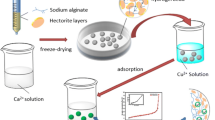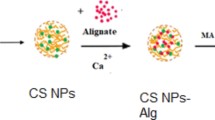Abstract
Alginate-Ca/attapulgite clay core/shell particles were synthesized via electro-coextrusion. Affecting parameters on the removal of uranium, such as pH, initial uranium concentration, temperature and co-existing cations were investigated. The uranium adsorption process was endothermic, feasible and spontaneous. The maximum adsorption capacity of the adsorbent for uranium was 199.345 mg/g at pH 3 and at 328.15 K. The results showed that the pseudo-second-order model and the Langmuir isotherm model fitted well with the data obtained. Based on the adsorption–desorption study, the adsorbent shows excellent reusability. The mechanism of uranium adsorption on the adsorbent was a combination of ion-exchange and an electrostatic interaction.















Similar content being viewed by others
References
Yuan DZ, Chen L, Xiong X, Yuan LG, Liao SJ, Wang Y (2016) Removal of uranium (VI) from aqueous solution by amidoxime functionalized superparamagnetic polymer microspheres prepared by a controlled radical polymerization in the presence of DPE. Chem Eng J 285:358–367
Ren B, Fan MQ, Tan LC, Li RM, Song DL, Liu Q, Jing XY (2016) Electrospinning synthesis of porous Al2O3 nanofibers by pluronic P123 triblock copolymer surfactant and properties of uranium (VI)-sorption. Mater Chem Phys 177:190–197
Rafati L, Mahvi AH, Asgari AR, Hosseini SS (2010) Removal of chromium (VI) from aqueous solutions using Lewatit FO36 nano ion exchange resin. J Environ Sci Eng 7:147–156
Agrawal YK, Shrivastav P, Menon SK (2010) Solvent extraction, separation of uranium (VI) with crown ether. Separation and purification technology. Sep Purif Technol 20:177–183
Villalobos-Rodríguez R, Montero-Cabrera ME, Esparza-Ponce HE, Herrera-Peraza EF, Ballinas-Casarrubias ML (2012) Uranium removal from water using cellulose triacetate membranes added with activated carbon. Appl Radiat Isot 70:872–881
Cui H, Qian Y, Li Q, Wei Z, Zhai J (2013) Fast removal of Hg(II) ions from aqueous solution by amine-modified attapulgite. Appl Clay Sci 72:84–90
Fan QH, Li P, Chen YF, Wu WS (2011) Preparation and application of attapulgite/iron oxide magnetic composites for the removal of U (VI) from aqueous solution. J Hazard Mater 192:1851–1859
Wang XH, Zheng Y, Wang AQ (2009) Fast removal of copper ions from aqueous solution by chitosan-g-poly (acrylic acid)/attapulgite composites. J Hazard Mater 168:970–977
Pang C, Liu YH, Cao XH, Hua R, Wang CX, Li CQ (2010) Adsorptive removal of uranium from aqueous solution using chitosan-coated attapulgite. J Radioanal Nucl Chem 286:185–193
Hu T, Tan LQ (2012) Modifying attapulgite clay by ammonium citrate tribasic for the removal of radionuclide Th(IV) from aqueous solution. J Radioanal Nucl Chem 292:819–827
Wang Q, Hu X, Du Y, Kennedy JF (2010) Alginate/starch blend fibers and their properties for drug controlled release. Carbohydr Polym 82:842–847
Yu J, Wang J, Jiang Y (2017) Removal of uranium from aqueous solution by alginate beads. Nucl Eng Technol 49:534–540
Ho YS, McKay G (1999) The sorption of lead (II) ions on peat. Water Res 33:578–584
Ho YS, McKay G (1999) Pseudo-second order model for sorption processes. Process Biochem 34:451–465
Baskaralingam P, Pulikesi M, Elango D, Ramamurthi V, Sivanesan S (2006) Adsorption of acid dye onto organobentonite. J Hazard Mater 128:138–144
Zhang H, Niu Z, Liu Z, Wen Z, Li W, Wang X, Wu W (2015) Equilibrium, kinetic and thermodynamic studies of adsorption of Th(IV) from aqueous solution onto kaolin. J Radioanal Nucl Chem 303:87–97
Ho YS, McKay G (2003) Sorption of dyes and copper ions onto biosorbents. Process Biochem 38:1047–1061
Cheung CW, Porter JF, McKay G (2001) Sorption kinetic analysis for the removal of cadmium ions from effluents using bone char. Water Res 35:605–612
Moller T, Harjula R, Pillinger M, Dyer A, Newton J, Tusa E, Araya A (2001) Uptake of 85Sr, 134Cs and 57Co by antimony silicates doped with Ti4+, Nb5+, Mo6+ and W6+. J Mater Chem 11:1526–1532
Sivakami MS, Gomathi T, Venkatesan J, Jeong HS, Kim SK, Sudha PN (2013) Preparation and characterization of nano chitosan for treatment wastewaters. Int J Biol Macromol 57:204–212
Bai CY, Zhang MC, Li B, Tian Y, Zhang S, Zhao XS, Li SJ (2015) Three novel triazine-based materials with different O/S/N set of donor atoms: one-step preparation and comparison of their capability in selective separation of uranium. J Hazard Mater 300:368–377
Heshmati H, Gilani HG, Torab-Mostaedi M, Haidary A (2014) Adsorptive removal of thorium (IV) from aqueous solutions using synthesized polyamidoxime chelating resin: equilibrium, kinetic, and thermodynamic studies. J Dispers Sci Technol 35:501–509
Wu LP, Lin XY, Zhou XB, Luo XG (2016) Removal of uranium and fluorine from wastewater by double-functional microsphere adsorbent of SA/CMC loaded with calcium and aluminum. Appl Surf Sci 384:466–479
Zhang YH, Lin XY, Hu SH, Zhang X, Luo XG (2016) Core-shell zeolite@Alg-Ca particles for removal of strontium from aqueous solutions. RSC Adv 6:73959–73973
Chen LF, Liang HW, Lu Y, Cui CH, Yu SH (2011) Synthesis of an attapulgite clay@ carbon nanocomposite adsorbent by a hydrothermal carbonization process and their application in the removal of toxic metal ions from water. Langmuir 27:8998–9004
Aly Z, Luca V (2013) Uranium extraction from aqueous solution using dried and pyrolyzed tea and coffee wastes. J Radioanal Nucl Chem 295:889–900
Aly Z, Scales N, Davis J, Lumpkin G (2017) Mesoporous polymer-coated PAN beads for environmental applications: fabrication, characterisation and uranium adsorption studies. J Radioanal Nucl Chem 311:43–57
Abdi S, Nasiri M, Mesbahi A, Khani MH (2017) Investigation of Uranium (VI) Adsorption by Polypyrrole. J Hazard Mater 332:132–139
Zhang ZB, Liu YH, Cao XH, Liang P (2013) Sorption study of uranium on carbon spheres hydrothermal synthesized with glucose from aqueous solution. J Radioanal Nucl Chem 295:1775–1782
Zhang ZB, Cao XH, Liang P, Liu YH (2013) Adsorption of uranium from aqueous solution using biochar produced by hydrothermal carbonization. J Radioanal Nucl Chem 295:1201–1208
Mahmoud MA (2016) Adsorption of U (VI) ions from aqueous solution using silicon dioxide nanopowder. J Saudi Chem Soc. doi:10.1016/j.jscs.2016.04.001
Acknowledgements
This work was supported by the National Key Scientific Projects for Decommissioning of Nuclear Facilities and Radioactive Waste Management (14zg6101), National Natural Science Foundation of China (21406180), Professional Scientific Research Innovation Team Building Fund Projects of Key Research Platform of Southwest University of Science and Technology (No.14tdsc02) and Postgraduate Innovation Fund Project by Southwest University of Science and Technology (17ycx004). The authors gratefully thank the technology support of Engineering Research Center of Biomass Materials, Ministry of Education, Southwest University of Science and Technology.
Author information
Authors and Affiliations
Corresponding author
Rights and permissions
About this article
Cite this article
Hu, S., Lin, X., Zhang, Y. et al. Preparation and application of alginate-Ca/attapulgite clay core/shell particle for the removal of uranium from aqueous solution. J Radioanal Nucl Chem 314, 307–319 (2017). https://doi.org/10.1007/s10967-017-5427-3
Received:
Published:
Issue Date:
DOI: https://doi.org/10.1007/s10967-017-5427-3




